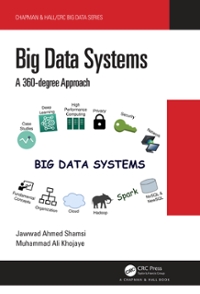Question
answer the questions throughout the program package producer_consumer; import java.util.Vector; //what does it mean that Consumer implements Runnable? // ans:It means that the class Consumer
answer the questions throughout the program
package producer_consumer;
import java.util.Vector;
//what does it mean that Consumer implements Runnable?
// ans:It means that the class Consumer is creating a thread by implementing the Runnable interface.
class Consumer implements Runnable {
private final Vector sharedQueue;
private final int SIZE;
private final int NUM_PROCESSED;
public Consumer(Vector sharedQueue, int size, int numProcessed) {
// sharedQueue is passed as a parameter from ThreadExample.
// So are there two copies of the Vector or One?
//2
this.sharedQueue = sharedQueue;
// how many copies of size are there among the three classes?
//6
this.SIZE = size;
this.NUM_PROCESSED = numProcessed;
}
public void run() {
while (true) {
try {
System.out.println("Consumed: " + consume());
// this puts the thread to sleep (paused for a bit) change it here and in
// Producer to combinations of 0 and 200 .
// what changes about the program? Why?
Thread.sleep(150);
} catch (InterruptedException ex) {
System.out.println(ex);
ex.printStackTrace();
}
}
}
private int consume() throws InterruptedException {
//wait if queue is empty
while (sharedQueue.isEmpty()) {
synchronized (sharedQueue) {
System.out.println("Queue is empty " + Thread.currentThread().getName()
+ " is waiting , size: " + sharedQueue.size());
// what does wait() do? why are you doing it in this part of the program?
sharedQueue.wait();
}
}
//Otherwise consume element and notify waiting producer
synchronized (sharedQueue) {
// what does notifyAll() do?
sharedQueue.notifyAll();
// what does remove(0) do?
return (Integer) sharedQueue.remove(0);
}
}
}
producer.java:
package producer_consumer;
import java.util.Vector;
// what does it mean that Producer implements Runnable?
class Producer implements Runnable {
private final Vector sharedQueue;
private final int SIZE;
private final int NUM_PROCESSED;
private boolean finished;
public Producer(Vector sharedQueue, int size, int numProcessed) {
//sharedQueue is passed as a parameter from ThreadExample.
// So are there two copies of the Vector or One?
this.sharedQueue = sharedQueue;
// how many copies of size are there among the three classes?
this.SIZE = size;
this.NUM_PROCESSED = numProcessed;
}
public void run() {
for (int i = 0; i < NUM_PROCESSED; i++) {
System.out.println("Produced: " + i);
try {
produce(i);
// this puts the thread to sleep (paused for a bit) change it here and in
// Consumer to combinations of 0 and 200 .
// what changes about the program? Why?
Thread.sleep(150);
} catch (InterruptedException ex) {
System.out.println(ex);
ex.printStackTrace();
}
}
System.out.println("finished with producer");
}
private void produce(int i) throws InterruptedException {
//wait if queue is full
while (sharedQueue.size() == SIZE) {
synchronized (sharedQueue) {
System.out.println("Queue is full " + Thread.currentThread().getName()
+ " is waiting , size: " + sharedQueue.size());
// what does wait do? Why are you doing it in this part of the program?
sharedQueue.wait();
}
}
//producing element and notify consumers
synchronized (sharedQueue) {
sharedQueue.add(i);
// what does notifyAll() do?
sharedQueue.notifyAll();
}
}
}
threadexample.java:
package producer_consumer;
import java.util.Vector;
public class ThreadExample {
public static void main(String[] args) throws InterruptedException {
// what does Vector
//ans : Vector is a collection object which helps to creates a dynamic array of elements in the queue.
Vector
// how does size change the program? try 7. try 2.
int vectorSize = 7;
int itemCount = 10;
// what in the world is happening here?? What is a thread?
// What is size? What is 10;
// ans: A thread is a path followed when executing a program. Every java program has atleast one thread
//called the main thread,invoked at the start of the program.
//Thread prodThread = new Thread(new Producer(sharedQueue, vectorSize,itemCount), "Producer");
//--creates a thread named prodThread of class Producer which implements Runnable interface.
//Thread consThread = new Thread(new Consumer(sharedQueue, vectorSize,itemCount), "Consumer");
//--creates a thread named consThread of class Consumer which implements Runnable interface.
//The size is 4.
//The itemcount limit is 10.
Thread prodThread = new Thread(new Producer(sharedQueue, vectorSize,itemCount), "Producer");
Thread consThread = new Thread(new Consumer(sharedQueue, vectorSize,itemCount), "Consumer");
// what does the start method of the Thread object do?
// What runs when the start method is called?
// what happens if you comment out one of the following lines? Why?
//prodThread.start();
//consThread.start();
//ans- The start() is responsible for creating a separate call stack for the thread and then run() is called by JVM.
//On starting the thread, the overridden run() gets executed which defines the specific functionality of the thread.
//On commenting one of the either statements, we will not be able to start the thread.start() is very important to start
//the execution of the thread.
prodThread.start();
consThread.start();
// what does the join method of the thread object do?
//join() allows the current thread to wait until the thread on which it is called is dead.If thread is interrupted then it will throw InterruptedException.
prodThread.join();
consThread.join();
// erase "throws InterruptedException". You get an error with the two joins.
// Fix it with a try catch. What is happening? What exactly is a InterruptedException?
// What happens if either the producer thread or consumer thread stops executing unexpectedly?
// HARD Question. This code produces an infinity loop. Why?
}
}
Step by Step Solution
There are 3 Steps involved in it
Step: 1

Get Instant Access to Expert-Tailored Solutions
See step-by-step solutions with expert insights and AI powered tools for academic success
Step: 2

Step: 3

Ace Your Homework with AI
Get the answers you need in no time with our AI-driven, step-by-step assistance
Get Started


